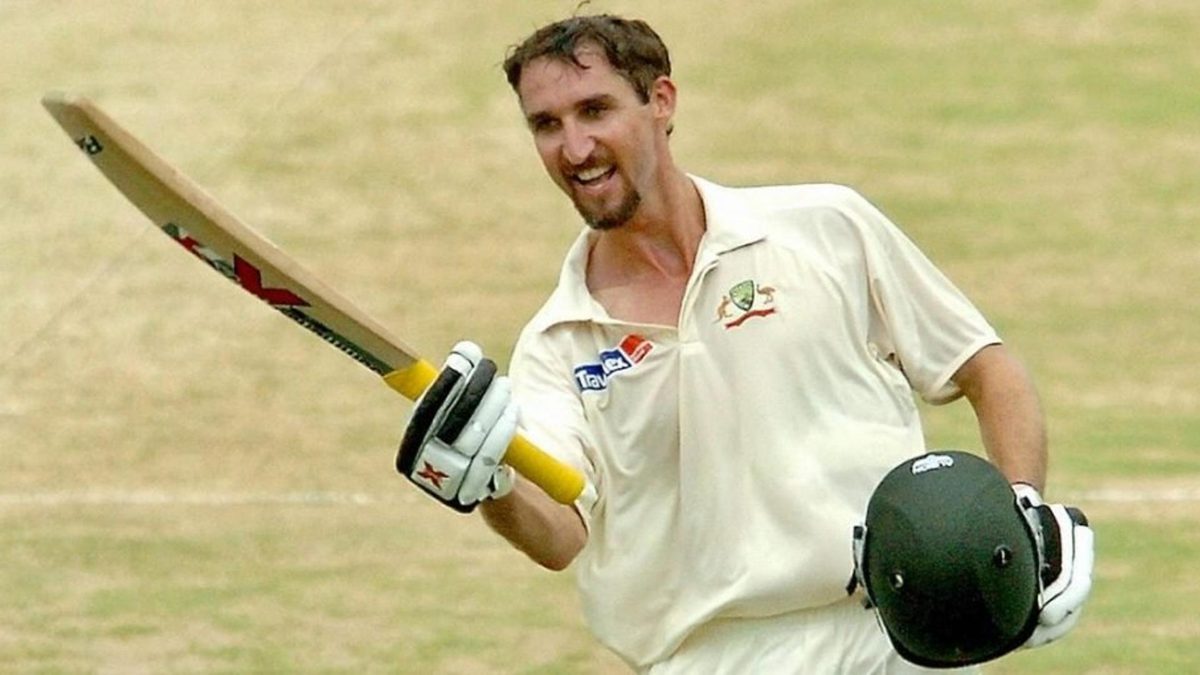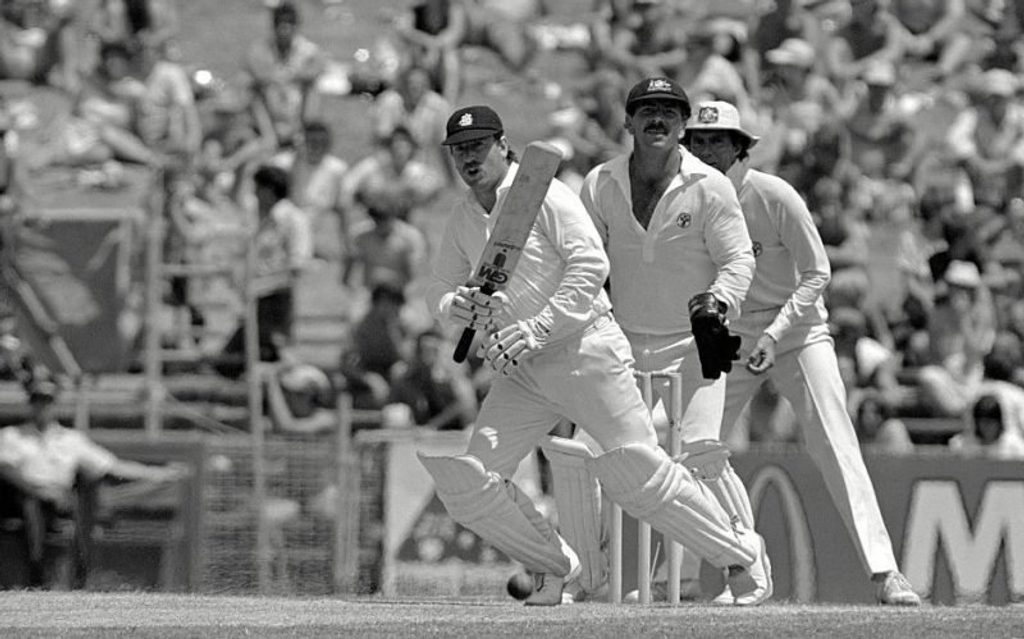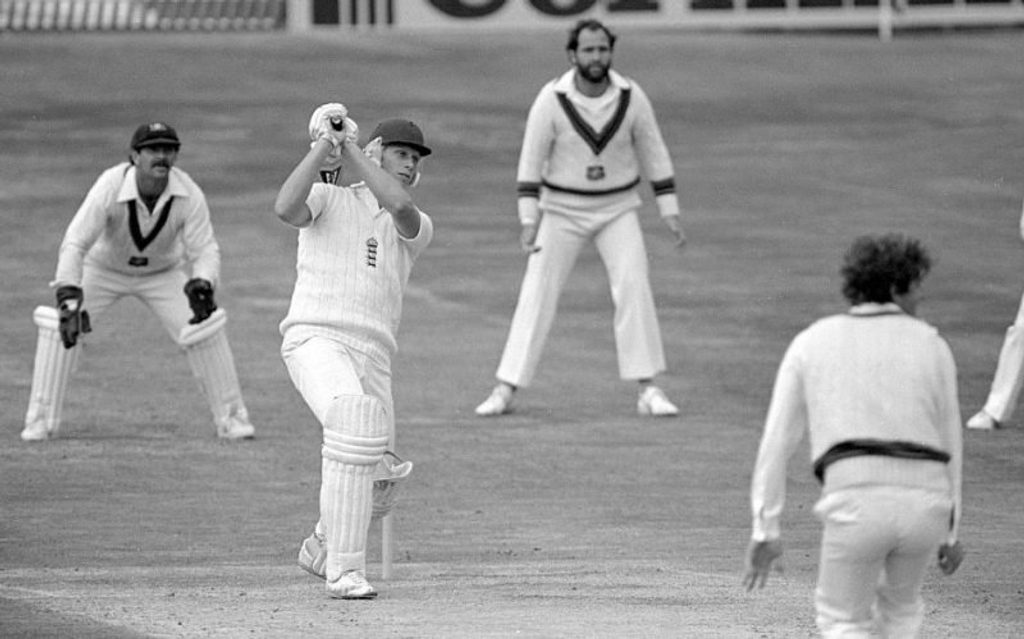
Ed Davis, Richard Dawson and Phil Walker pick out 10 acts of genius from absolutely nowhere – a collection of brilliant but unexpected performances.
First published in 2007
First published in 2007
10) Jack Richards v Australia
Perth 1986
Richards was an efficient keeper for Surrey whose no-frills no-thrills batting saw him elevated to the England side just in time to take part in England’s triumphant 1986/87 Ashes tour under Mike Gatting.
Initially picked as deputy to Bruce French, but in an England side desperately low on runs, Jack’s trusty front foot play got him the nod. He kept tidily but made a duck at Brisbane in his first Test, but his undoubted nirvana came in the second match, where he flayed the Aussie attack all round the ground for four hours and, in partnership with Gower, racked up 133 critical runs. England drew the match, but won the series.
He never again passed 50 for his country and went on to win just eight caps.
– ED
9) Nathan Astle v England
Christchurch 2002
Bit out of leftfield this one, for Astle could definitely bat. A record of 11 Test centuries at an average of 37 is nothing to be sneezed at. He could score runs – whilst maintaining a façade of utter relaxation – but in truth he was one of Test cricket’s nearly men, a ‘good eye’ player marked by a suspect defence and impetuous shot selection.
In hindsight, it was the perfect combination for what lay ahead on the fourth afternoon at Christchurch in 2002, against England’s rampant attack. New Zealand were chasing 550 after an exceptional double-ton from Graham Thorpe and a maiden century for Flintoff had put them out of sight. With 417 the highest successful fourth-innings chase in history, ‘no chance’ was the general consensus. A draw aided by rain was surely their only hope.
https://www.youtube.com/watch?v=PE8q2l2gRAk
Astle was always a bit loose, a bit breezy – not normally the sort of man you’d want in this situation. Convention says you want a ‘backs to the wall’ scrapper, someone to dig in and build an innings, someone to bat time and salvage your pride before bowing to the inevitable defeat. Bollocks to that, said Nath.
Instead he went ballistic and slammed the fastest ever double-hundred in Test match history, crashing 222 runs off 168 balls including 28 fours and 11 sixes. He was last man out – caught behind off a Hoggard slower ball – but with Chris Cairns not out at the other end, New Zealand were only about 45 minutes and 98 runs away from the greatest single effort in history. If he’d done it, it would have been the greatest knock ever, bar none.
– ED
8) Allan Border v West Indies
Sydney 1989
No one argues that Captain Grumpy was an awesome cricketer. An average of 50 and 11,174 runs at Test level is rather useful. Toss in the fact that he held the record for Test appearances both as a player and as captain, as well as the record for outfielder’s catches, and you begin to appreciate that AB could play.
But with the ball? AB wasn’t all that crash hot. He was a part-time twirler of the left-arm variety who seemed to just bowl straight ones at two speeds, slow, or elderly granny at Sainsbury’s slow. But, as happens in this stupid game, against a star-studded West Indies side back at the advent of the Nineties he was bizarrely unplayable.
One from the archives.
David Wilkinson remembers 10 special part-timer performances, including the remarkable story of how WG Grace once had his wicket taken by Sir Arthur Conan Doyle. 🕵️https://t.co/v38whoS5CU
— Wisden (@WisdenCricket) July 25, 2020
Producing a sequence of utterly vicious, spitting deliveries, Border removed Viv Richards, Carl Hooper, Richie Richardson and Gus Logie on his way to figures of seven wickets for 46. He celebrated in customary style by grinding out the fifth slowest Test half-century in history over the course of five hours, then rolled up his sleeves again and took 4-50 second time around.
Australia won by seven wickets and Border was the first Australian captain to take a 10-wicket haul. Part-time tweakers the world over celebrated wildly as one of their own came good.
– RD
7) Eddie Hemmings v Australia
Sydney 1983
Eddie had one of those games at the SCG. A surprise pick for the 1982/83 Ashes tour, his trademark bristling ‘tache, constricting off-spin and nuggety lower-order batting made him a firm favourite with team-mates and fans alike. Think a cricketing Tom Selleck missing about three feet of height. From Leamington Spa.
 Eddie Hemmings scored a career best 95 while batting at No.3
Eddie Hemmings scored a career best 95 while batting at No.3
Having already taken six wickets, Hemmings was asked to go in as nightwatchman as England looked to bat out shedloads of time to save the Test. We all know the drill: Go out there, nick all the strike, don’t play any shots and don’t get out. Against Jeff Thomson, Geoff Lawson, and Rodney Hogg. Fun times ahead…
Hemmings went one better. In fact, he went a lot better. He saw out the close of play, came back the next day and dished out more punishment to the Aussie speed machines. His valiant 95, which spanned 223 minutes, helped England to bat for the whole day and save the Test. Pure guts.
– RD
6) Narendra Hirwani v West Indies
Chennai 1988
Plucked from obscurity at the tender age of 19, the bespectacled leg-spinning flight-meister Hirwani made his Test bow for India on a pitch that was quite utterly, utterly filthy.
Debuting as a 19-year-old against the mighty West Indies in ’88, Hirwani returned the best-ever bowling figures on debut.
He dismissed Viv Richards in both the innings 😮 pic.twitter.com/n5bokRdjIZ
— Wisden India (@WisdenIndia) July 23, 2020
And what a bow. The boy bowled his way to record-breaking match figures of 16-136, the best figures yet recorded by a Test debutant, as the ball turned squarer than extra maths. He went on to snare 20 more wickets in his next three Tests, but upon leaving the sub-continent’s myriad of bunsens and being introduced to the business end of Mr Graham Gooch’s railway sleeper, he was suddenly rendered mortal.
He went on to play 17 Tests but never regained the magic of his early days and his stats slowly headed skywards. The arrival of a certain Anil Kumble put paid to any further international ambitions.
– ED
5) Jason Gillespie v Bangladesh
Chittagong 2006
All Out Cricket columnist Jason ‘Dizzy’ Gillespie looked like Dick Dastardly’s evil brother, bowled like the wind until England got on top of him during the 2005 Ashes, and blocked anything that was in the same postcode as his stumps. Top bloke, top player.
Culled from the Australian side in the aftermath of that heavenly time, Gillespie was recalled to the baggy green to provide some experienced cover for the 2006 series in Bangladesh. He bowled well, if not quite with the same venom as in his pomp, but it was with the bat that the freshly non-mulleted Dizzy attained new heights of prowess.
https://www.youtube.com/watch?v=9sny6UmZJDQ
Sent in as nightwatchman during the second Test, Gillespie decided half-measures were for quitters and celebrated his 31st birthday by occupying the crease for a staggering 425 balls whilst nudging, nurdling and heaving his way to an unbeaten 201. He became the first ever nightwatchman to score a double century and passed the personal bests of such luminaries as the Waugh twins and the formidable David Boon.
After completing his epic, Gillespie summed it up perfectly: “Hansel and Gretel and Dizzy’s double hundred, it’s one and the same. Absolute fairytale.”
– RD
4) Danny Morrison v England
Auckland 1997
Danny Morrison couldn’t bat. Sure, the boy could bowl – his slingy action and sharp outswingers picked up 160 Test wickets in 48 matches for the Black Caps. But with the bat he was inept, as a record of 24 Test ducks will attest. He made Peter Such look like a dashing strokemaker, and could often be found flailing at a length ball somewhere around square-leg.
So when he strolled out to bat against England with the Kiwis nine down, loads behind and three hours to play, observers could be forgiven for thinking the game was done and dusted. The England team could probably taste the celebratory beer on their lips.
 Danny Morrison and Nathan Astle celebrate after clinching an epic draw
Danny Morrison and Nathan Astle celebrate after clinching an epic draw
Morrison contributed 14 runs in a match-saving last-wicket stand of 106 with Nathan Astle. He safely repelled 133 deliveries from an attack comprising Darren Gough, Craig White, Dominic Cork, Alan Mullally and Phil Tufnell, and never once looked like getting out. England, and the cricketing world at large, was struck dumb.
Despite his unexpected heroics, Morrison was dropped and never featured for his country again, a harsh end for a great servant to New Zealand cricket.
– RD
3) Ted Alletson v Sussex
Hove 1911
Ted Alletson finished his 119-match first-class career at Notts with a batting average of 18.59. That is, to be blunt, not that good. But for one ridiculous day, Ted, whom it has been alleged had previously had a reputation as a bit of a blocker, was genius and brutality all wrapped up in a pair of grubby whites.
Going in with Nottinghamshire staring down the barrel at 258-8, just nine runs ahead with Sussex due to bat again, folklore has it that Alletson was told by his captain that it probably wouldn’t matter what he did. Ted replied: “Then I’m not half going to give Killick some stick!” That’s Sussex bowler Tim Killick (keep up!), and although his response is unknown, we can hazard a guess.
He was as good as his word. What followed is simply known in cricketing circles as the ‘Alletson innings.’ In a display of sustained hitting he racked up 189 runs in just 90 minutes, 142 of those runs coming in the last 40 minutes. To those with a more modern bent when it comes to statistics, Ted at one point scored 115 runs off seven (seven!) overs.
Nothing was safe. Ted demolished the pavilion bar, and the clock, and generally leathered the ball about with such glorious abandon that the unfortunate Killick, who had been swatted for a then record 34 runs off a single over, admitted fearing for his safety. He was eventually caught on the boundary, although Notts supporters attest to this day that the fielder was over the boundary rope. It was his only first-class century.
Ted’s onslaught saved the game for his side as the shell-shocked Sussex team could only limp to 213-8 in their second innings, falling 24 runs short of victory.
It is probably fair to say that Ted had greater potential as a bowler rather than as a wielder of the willow. He could bowl lively seamers, and in his latter years it is said he developed a searing finger-spun leg-break delivered at tremendous speed that started taking wickets like they were going out of fashion but was prevented from bowling them by killjoy umpires.
No matter. Ted kept the bat he used on that fateful day in a place of honour in his parlour in Worksop and never tired of discussing his historic performance with young and old alike.
If you’d done it, you wouldn’t either.
– ED
2) Bob Massie v Engand
Bob Massie’s performance on his debut was even bigger than his sideburns. A whole-hearted swing bowler who operated in the ‘brisk not quick’ category and who was once average enough to be rejected by Northants, Massie was picked for the Lord’s Test in June 1972 because he was seen as the ideal horse for that most peculiar course.
The North London green deck and leaden skies that greeted the two teams suited Massie perfectly. A strong England side won the toss and elected to bat, hoping to ride out any early movement and grind their opponents into submission. Good plan, in theory. Unfortunately for Ray Illingworth’s boys, the ball went round in circles, let alone corners, and Massie was in business.
Geoff Boycott, Tony Greig, Alan Knott et al were shot out for 272 and Sideshow Bob was suddenly the main draw, picking up eight wickets for 84 runs, supported by a brace for arch Pom-basher Dennis Lillee. Australia made 308 in reply thanks largely to a century from Greg Chappell, and England were under the cosh. What had Massie got by way of an encore?
More, much more, of the same. Bob ripped through the England batting line-up again and returned figures of 8-53 as England were skittled out for 116. His match figures of 16 wickets for 137 would not be bettered by a Test debutant for 15 years.
Yet the man – short, wiry, sensitive, unAustralian – would play just six more Tests and a trio of ODIs, as his form dips alarmingly, and he suffers the indignity of being dropped by Western Australia, his state side just 18 months after his Lord’s exploits.
Massie would go on to forge a successful career as a banker and commentator. But for one English summer afternoon, he was the biggest swinger in town.
– ED
1) Graham Dilley v Australia
Headingley 1981
History can be so cruel. The game that will forever be associated with Sir Ian Botham (or to give him his correct title: Sirloin of Beef) featured other freakish performances of sweat and fire and inspiration. Some of these contributions have even managed a slot on the radar, albeit 149 rungs beneath the shining Botham legend.
Although awe-inspiring, the spell when a barely hinged Bob Willis flattened the Aussies was not a complete shock, as the most ghostly presence to sport a perm since Marc Bolan had been England’s spearhead since time began. That was his job, he’d done it before and here he was doing it again, definitively; Bustling Bob, a child of the revolution, commands a hefty footnote in the story of Headingley ’81.
 Graham Dilley drives one through covers off Terry Alderman during his crucial 56
Graham Dilley drives one through covers off Terry Alderman during his crucial 56
But what does get buried, under Beefy’s bulk, is the equally dramatic story of what happened at the other end when Botham was swinging to his century. Few people, for example, remember Chris Old’s crucial 29 from number ten in a partnership of 67 with Botham, but then Old could hang around a bit: the man had six first-class hundreds.
And Old’s pluck – vital in itself – would have meant nothing without the surreal 80 minutes that preceded it.
Graham Roy Dilley was 22 in 1981, and Headingley was the 12th match of an injury-plagued 41-Test career. He was a quick bowler, known for his huge delivery stride, shock of blond hair and, in those early years, serious pace. He was certainly not known for his batting.
But timing is everything. When Dilley joined Botham at 135-7, still 93 runs shy of making Australia bat again, in the gloom, on a grubby pitch, against Lillee and Alderman, the neon scoreboard blared those 500-1 odds on an England win. Botham told him to have a giggle. Enjoy it, the game’s gone: have a whack! Dilley took guard.
It is worth noting at this stage the pedigree of the batsman. In his 16-year, 234-match first-class career for England, Kent and Worcestershire, Dilley, a left-hander, would manage four half-centuries. Four. From 1977 to 1992, he would hit a 50 once every four years.
So there is no evidence to explain what happened that day, and yet from that first improbably uppish drive through the covers, something inexplicable, and magical, began to take shape.
Lillee and Alderman were one of the great fast bowling partnerships, miserly, deadly accurate, clever, and ruthless when they had their opponents down. Alderman tortured England’s batsmen that summer, and for many summers to come, by plonking the ball in roughly the same spot – outside the right-hander’s off stump, swinging into the pads – every time he bowled. It was simple and lethal. But because Dilley was a left-hander, those inswingers arced away from his pads and into his hitting zone. The angle allowed Dilley to hit through the line, and to everyone’s surprise, he started connecting. With Botham being hilarious at the other end, Dilley’s shy face – watch the footage and he seems almost embarrassed by the theatre – cracks into a smile.
https://www.youtube.com/watch?v=oG7oRGEh9KM
And so for 80 mad minutes, Dilley matches Botham shot for shot (whisper it, but he actually outdoes him for purity of stroke), and between them they smash 117, with Dilley making 56 with nine fours. In his knock there is one inside edge past the stumps, but the rest are lacerated on the up through the offside, Clive Lloyd-style. And this is not some wild fluke slog; Dilley keeps his shape, shifts his front leg a touch, and plays proper cricket shots. It is thrilling; thrillingly absurd.
Eventually Alderman cottons on and goes round the wicket, and Dilley is immediately bowled through the gate, no problem at all. As the stumps break Alderman instinctively drops his head and his chest decompresses. He looks broken. In his sunken body, in place of celebration, there’s a turbulent cocktail of relief and shame instead, and exhaustion, and the gnawing, barely comprehensible fear of where this chaos might suddenly lead. Or at least, that’s what England’s dressing room would have seen. And IT Botham, standing on his bat at the non-striker’s eyeing the confectionary stall at long-off, he would have noted it too. Dilley walks off, still bashful, to a standing ovation. He would never do anything like this ever again. England are now eight down and 25 ahead. Chris Old passes him on his way out.
Alderman was right to be fearful.
– PW








